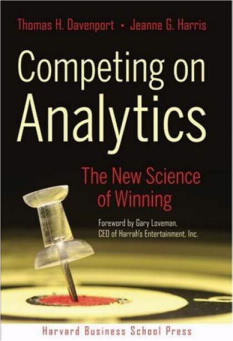by Andrea Kates, Founder, Business Genome™
The number of numbers that companies use to charge toward growth is astounding.
 The innovation gurus love to snicker at the green eye shade types who insist that double digit growth for the coming year is as simple as last year’s spreadsheet times 1.10. Which, in times of steady growth and simple patterns, isn’t a bad way to look smart.
The innovation gurus love to snicker at the green eye shade types who insist that double digit growth for the coming year is as simple as last year’s spreadsheet times 1.10. Which, in times of steady growth and simple patterns, isn’t a bad way to look smart.
And the analytical types have been known to dismiss the wild antics of the creative spirits who bring “outside the box,” “off the whiteboard,” and “coloring outside the lines” approaches to the issue of growth. What if we make the tacos purple? Let’s bring in poets and anthropologists to find untapped market opportunities. We can develop the next Post-It note if we keep brainstorming.
In times of economic stress, we need to hasten our success toward growth opportunities that work. We need to provide results: upward sales figures, increased value, and solid investment in assets that will appreciate substantially over time.
We need proof that we’re on a growth path and we need numbers that will back up our hunches.
At the same time, predictive and probabilistic numbers and models have failed us. We have constructed numbers that are intended to provide certainty and offered others to our employees and shareholders that promise outcomes. We have optimized our counting systems around many different priorities: having an easy-to-audit set of numbers, tracking things that have been bought and sold, measuring prices and capturing trends. It’s no wonder we have started to confuse which numbers tell us what and how to use numbers with a specific eye toward future growth.
The issue isn’t whether or not numbers matter. It’s whether the numbers you’re gathering and analyzing are the right numbers to charge into an uncertain future on a growth vector.
Our gut tells us that if we keep painting the same picture with different paint, we’ll never really achieve growth, especially in an economically-distressed market. But, we are hard-pressed to find new canvases with new numbers that could guide our strategic path to growth.
Conventional wisdom tells us that analysis of numbers reduces risk and that creativity upsets the apple cart. It’s actually the combined approach that reduces risk, by thinking extremely creatively about your company’s future and by gathering information and analytics in a new way to cobble together data models that keep you on your toes.
Today’s times call for a new approach to analytics based on patterns of success that combine the best of both approaches: analytics and creativity.
The Business Genome™ offers some of the fine points of this approach to analytics:
| Old Approach to Analytics | Business Genome Approach to Analytics |
|---|---|
| Benchmarking based on current peers | Comparisons based on future competitors |
| Risk curves based on in-industry standards | Out-of-industry and cross-industry metrics |
| Backward-facing measures | Hybrid measures based on customer buying patterns and market trends (forward-looking) |
| Predictive modeling | Resilient tracking and modeling (real time, future-focused) |
| Watching results | Monitoring contributing factors and emerging trends (including long-tail) |
| Numbers owned by few | Numbers managed by many (gathered, monitored, modeled) |
| Goal = Certainty | Goal = Nimbleness |
MBA + NBA = A New Approach to Winning
 A prime example of an industry that is benefiting tremendously from a new approach to the numbers comes from sports, where the revolution in statistics begun by the likes of Bill James in baseball is now reflected in people like Sam Hinkie in basketball. Sam Hinkie, vice president of basketball operations and head of basketball analytics for the Houston Rockets, comes to the NBA with an MBA from Stanford. He also exemplifies a new way of using analytics to drive wins, and we can look at his example as inspiration for how a new way of looking at metrics can fuel a new approach to driving business, which in his case means wins.
A prime example of an industry that is benefiting tremendously from a new approach to the numbers comes from sports, where the revolution in statistics begun by the likes of Bill James in baseball is now reflected in people like Sam Hinkie in basketball. Sam Hinkie, vice president of basketball operations and head of basketball analytics for the Houston Rockets, comes to the NBA with an MBA from Stanford. He also exemplifies a new way of using analytics to drive wins, and we can look at his example as inspiration for how a new way of looking at metrics can fuel a new approach to driving business, which in his case means wins.
A recent article described the new school of thought for sports statistics, based on understanding of new numbers to track in his sport, numbers that have led to a new philosophy in scouting, recruiting, strategizing, coaching, and ultimately winning.
Hinckie’s new read of analytics, drove him to understand why Shane Battier, a player who “doesn’t grab many rebounds can be [The Rockets] most valuable player.”
“When (Shane) Battier guards (Kobe) Bryant, the Lakers’ offense is worse than if the NBA’s best player took the night off.”
Hinckie’s analytics provided new equations for valuing specific players even without scoring points directly, Shane Battier proved to be the killer app on the floor, and his value was revealed to the likes of Sam Hinckie because Hinckie took his eyes off the old metric for valuing players based on points scored and put his focus on the metrics of how many times a player like Battier could “kick a player like Kobe Bryant from his good zone to his bad zone.” Which has been responsible for a surprising number of wins.
The business press has taken on the challenge of which numbers matter. Competing on Analytics: The New Science of Winning offers some helpful ideas about the power of metrics, and widespread skills within an organization to integrate numbers into decision making.
Their ideas about how more pervasive Business Intelligence (BI) software and how more real time analytics will improve decision making are compelling.
As long as we don’t get lured into the fog of forgetting which numbers are telling us what and as long as we don’t use better analytical tools to do a fancier and faster job of measuring the distance between deck chairs on the Titanic instead of noticing the patches of ice in the distance.
The question is: How much of a revolution in analytics is called for right now, as the tools for measuring are becoming more and more sophisticated and the ability to count things can be done faster and faster?
Who better to set a revolutionary tone than Bob Dylan, who offers a great coda to the theme?
Musical Coda
When I Paint My Masterpiece by Bob Dylan
Someday, everything is gonna be smooth like a rhapsody
When I paint my masterpiece.
Sailin’ ’round the world in a dirty gondola.
Oh, to be back in the land of Coca-Cola!
I left Rome and landed in Brussels,
On a plane ride so bumpy that I almost cried.
Clergymen in uniform and young girls pullin’ muscles,
Everyone was there to greet me when I stepped inside.
Newspapermen eating candy
Had to be held down by big police.
Someday, everything is gonna be diff’rent
When I paint my masterpiece.
Which numbers will you use in the future to create your greatest hits?

